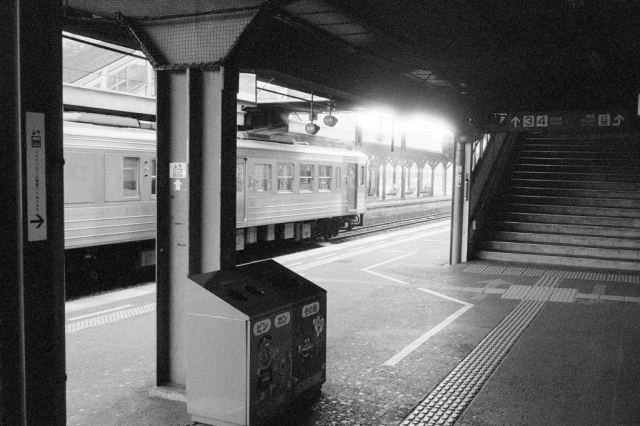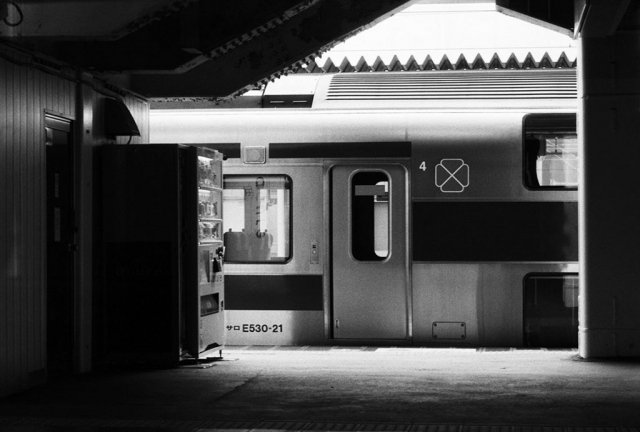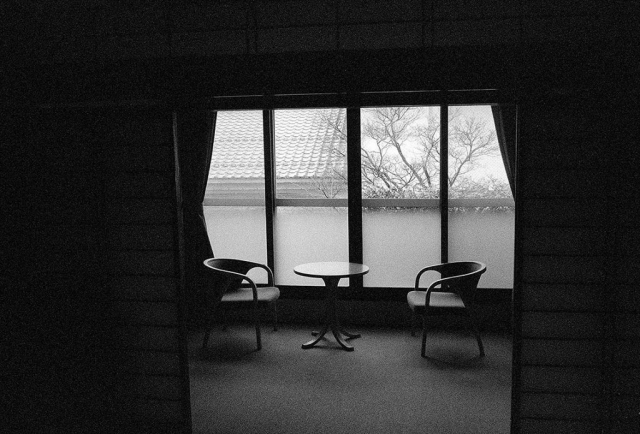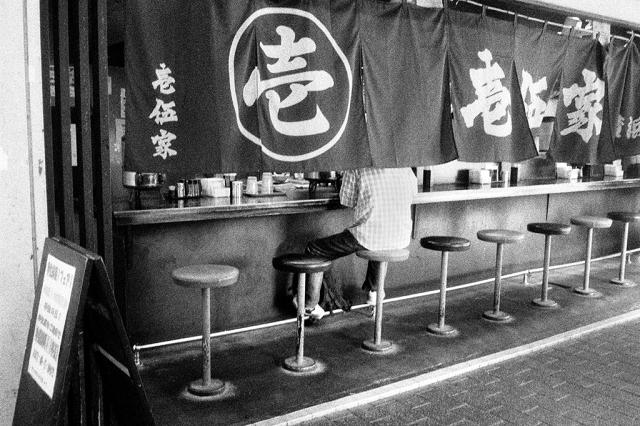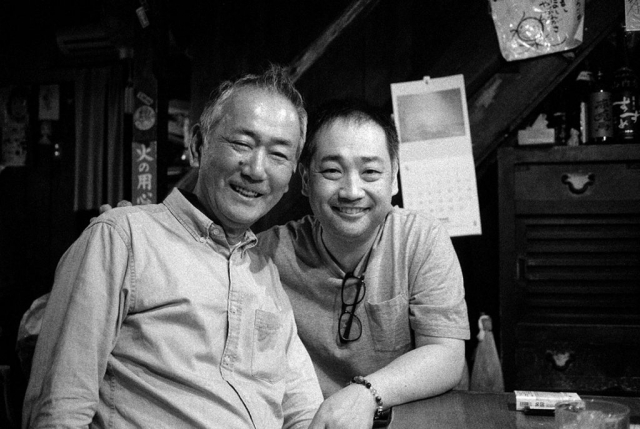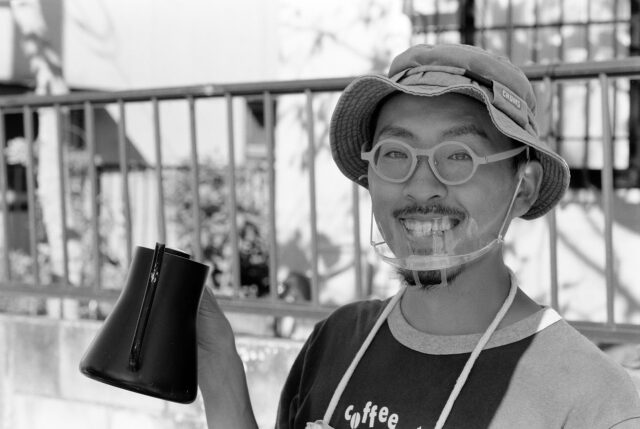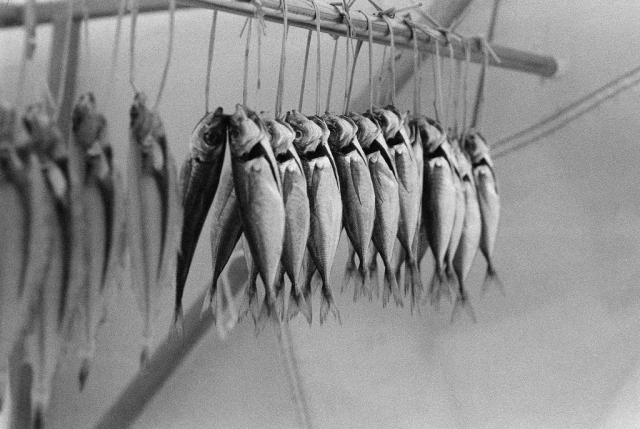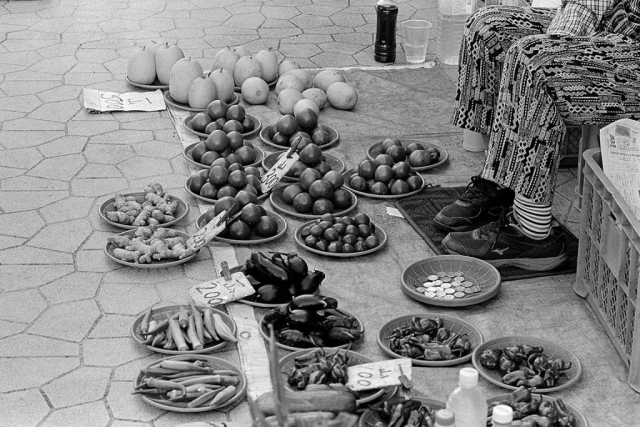Preface
I have a unique story, based on my travel with my camera through the 47 prefectures of Japan, mostly by local train, and now it’s time to tell my story through the medium of photography.
My dilemma is whether to start my story at the level of individual images (in which case readers would be unable to see the big picture) or to start by describing the big picture first (in which case readers might be impatient to see the actual photographs). As usual when I face a dilemma, I look for a compromise. Let me start with a bird’s eye view of the outcome and then go back to the beginning with the individual photographs.
Now let me describe the background. The series grew out of a conversation I had a few years ago with a Japanese colleague. He asked me how many prefectures I had visited in the 10+ years I’d been living in Japan at the time. To my chagrin, I had to admit that I’d only visited a few prefectures outside of the major cities like Kyoto, Osaka and so on. It became a challenge to visit all 47 prefectures.
Before moving on to the photographs, a brief synopsis of the scope of my undertaking may be fruitful. Japan is a small country geographically, with a land area similar to that of California. It is an archipelago with nine main islands and countless smaller islands. The country is divided into 47 prefectures or geopolitical units, stretching from Okinawa at one end to Hokkaido at the other. I traversed these prefectures in no particular order, usually in 4-5 day segments, mostly over a period of about 5 years though some of the trips were spread out over the last 20 years. I traveled mostly by train and logged more than 30,000 km, about 10 times the entire length of Japan. I traveled light: only my camera bag and a small backpack.
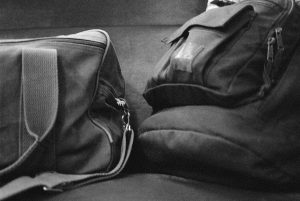
One more final comment before I begin my story of the 47-Prefectures series. I have traveled to all of the 47 prefectures and visited many places. The key element of the series is the content of my photographs. Location is usually of less importance. My narrative ignores both the location and the chronology for the most part.
Now, let me tell you my story based on the individual black-and-white images. The entire series of photographs is extensive, too much for a single installment of the Chronicles so I’ll spread them over five installments, and still some of the images will end up on the cutting room floor.
Not Street Photography
The theme of this installment of the Monochrome Chronicles series is “The 47 Prefectures of Japan.” Thus far in the Monochrome Chronicles, most of the images from Japan have been taken in Tokyo. Tokyo is only one part of Japan, of course, and so this next series deals with the rest of Japan. No, that is an egocentric viewpoint, a Tokyo-centric viewpoint. This series covers all of Japan including Tokyo.
My romance with street photography. Street photography is engrained in my experience behind the camera as described in previous episodes #04 through #06. Consequently, it seemed natural to continue with this genre for the project, but I soon discovered that street life in the prefectures, and especially in the small towns, was considerably different than in the cities. This is not surprising.
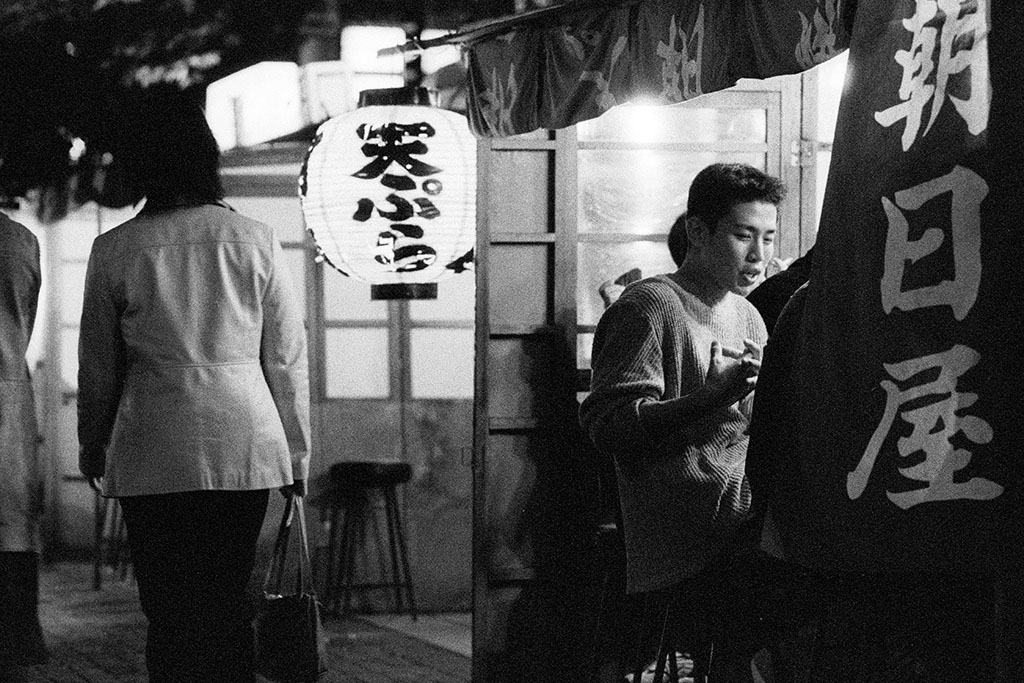
Allow me to backtrack briefly and explain about the origins of my romance with street photography. For one thing, I am a night person. Living in Chicago, and later in NYC, I gravitated to the nightlife. It was exciting. It offered, or at least promised, something that had been missing for me growing up in a small farming community in Iowa. Thus, when I got my start in black-and-white film, street photography was a natural progression for me. I continued to pursue this genre for the last 8 years of my time in NYC and later when I moved to Tokyo in 2003.
Well, I said that I’ve never analyzed why street photography attracts me so strongly, but maybe… I guess I’ve strayed off the track of the 47-prefectures series. Suffice it to say that, looking back now, I think I see a progression in this series. Initially I practiced street photography because it was my modus operandi and I knew the techniques. This worked well in the cities such as Kyoto and Osaka. I felt comfortable there. Later, in more remote cities and small towns, I had to modify my objectives as you will see in the photographs.
The first set of photographs are street scenes from smaller towns in the more remote prefectures. Out there the streets were mostly vacant during the daytime and the neighborhoods were quiet.
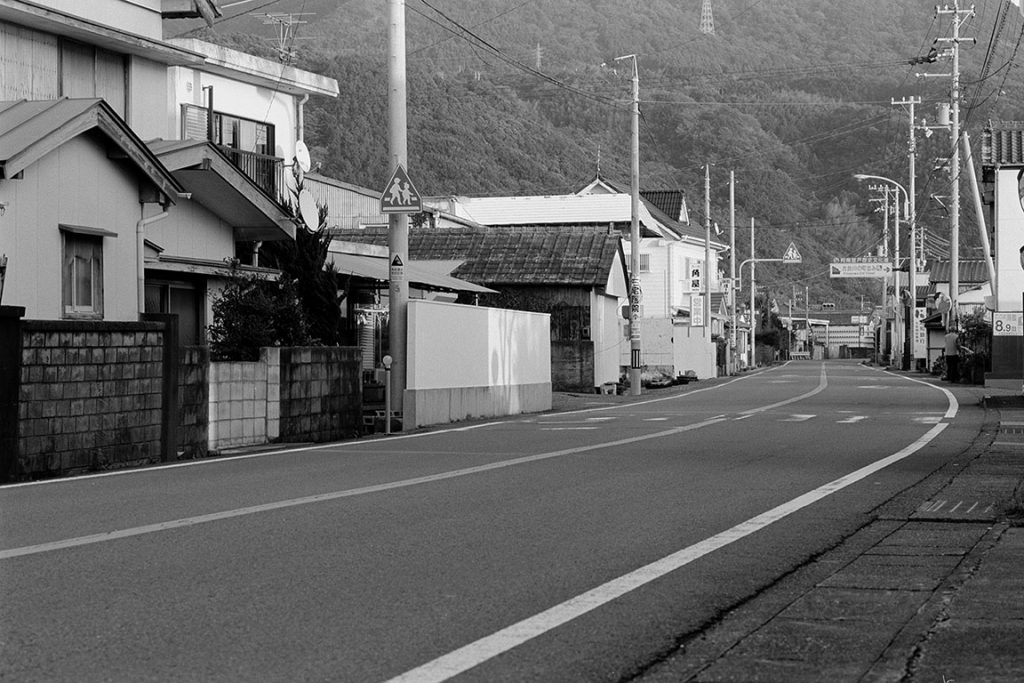
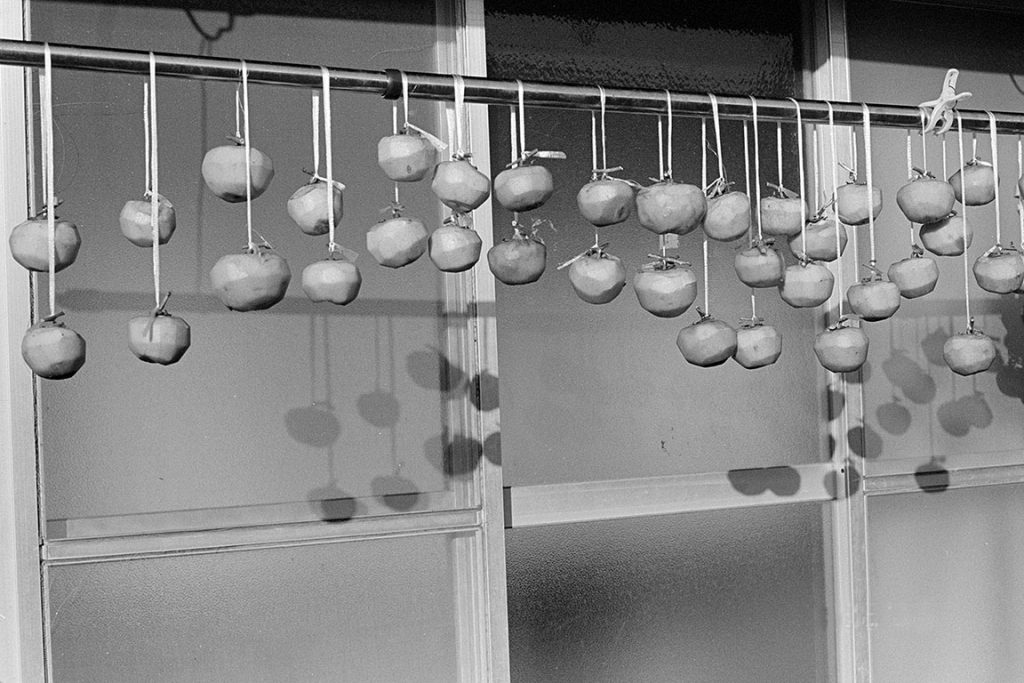

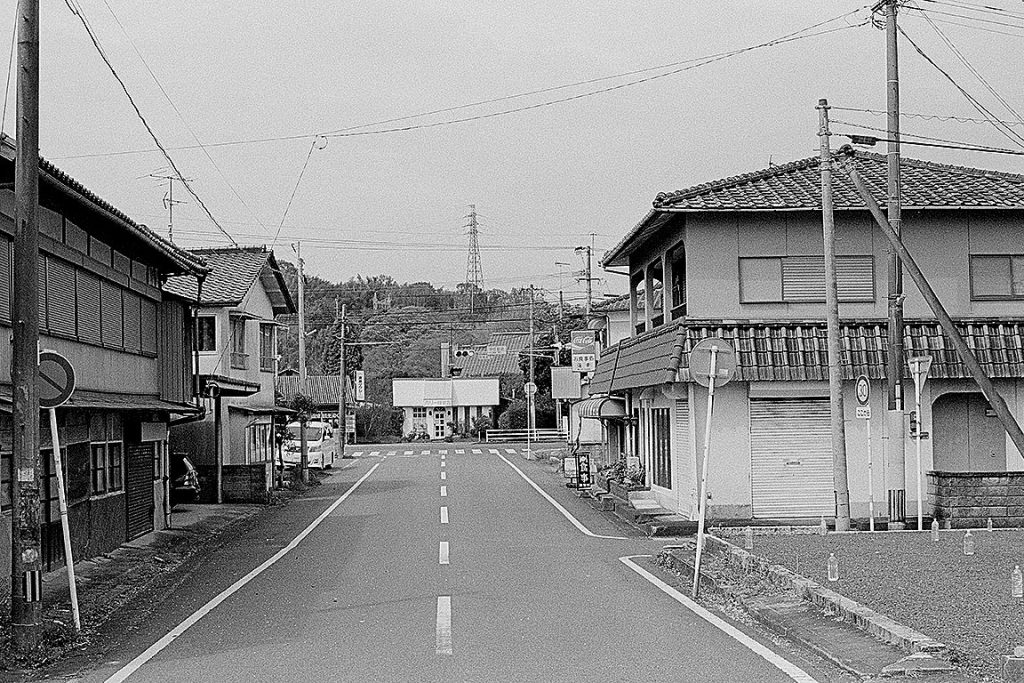
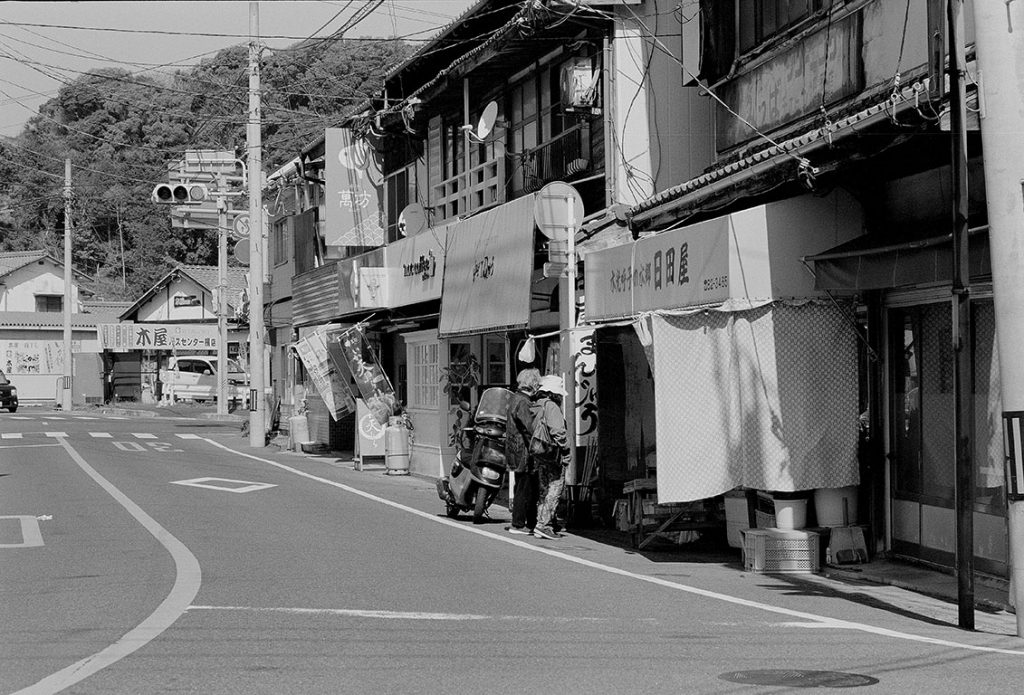

Two such differing views of the same street. One image features primarily the shops lining the street. The clutter of the shop fronts seems to be enhanced by the smooth, empty roadway. The time period, though in reality it was 2022, might easily have been 30 or 40 years ago. The companion image, with a different camera angle, features the human element. The woman, who has completed her morning shopping, was walking slowly along the street. This is a moment in time frozen on film. Both images are low on drama but portray the sense of life in a small town in the remote prefecture of Saga-ken. Or to put it another way, the lack of drama is the strength of these two images. Yokubo, Saga Prefecture
The unusual composition of this photograph sets it apart. A vacant lot dominates the image while the buildings seem to be in the background. In one sense the image toys with the viewer’s perception of perspective. In another sense, this is my perspective as a photographer.
The other element here is a view of the backside of a traditional Japanese house in a smaller town. Overall, and despite the unconventional composition, the view is basically geometric, the elements are complementary – and the end result is soothing, a calm moment of reassurance captured on film.
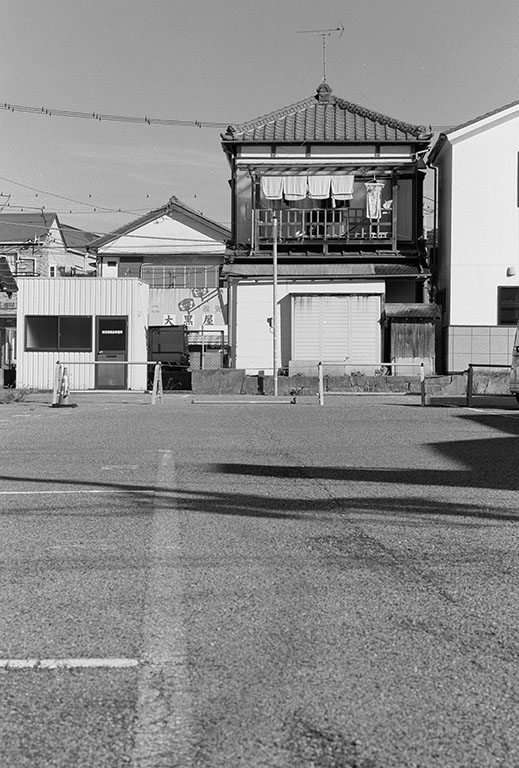
Street Portraits
Next is a series of what I call “street portraits,” which maybe unexpected in the circumstances. Basically, I am a private person, reluctant to approach strangers on the street. Added to this is my expectation that Japanese people would keep their distance from a stranger, obviously a foreigner, on their streets. Actually, I am more at ease when I’m behind the camera and Japanese people are more at ease when they find I can speak their language. Sometimes all the elements fall in line, even for a brief encounter on the streets.
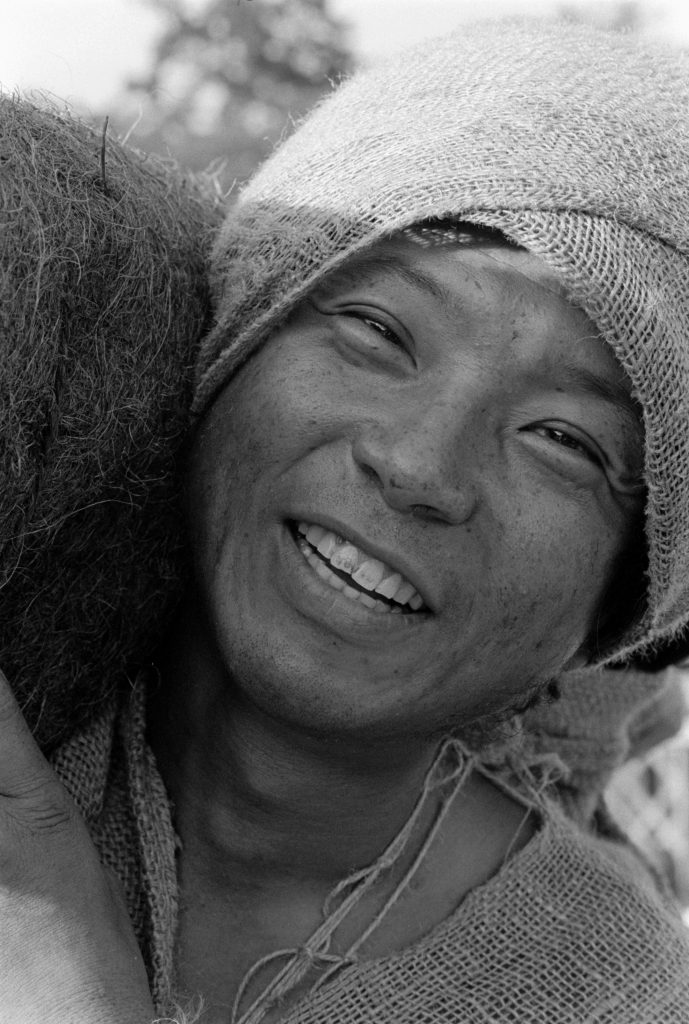
During my visit to Fukui City, as I was walking through its Central Park which sits near the site of the ruins of Fukui Castle, the figure of a man some distance away caught my attention. Two features made him distinctive. Actually I could only see him in silhouette but his clothing was unconventional and also he was carrying on his shoulder what seemed to be a very wide rolled-up carpet or some such item. I followed behind him for a while and saw that he was dressed all in burlap. He wore a sort of shapeless tunic, from his shoulders to his knees, and burlap sandals on his feet. He wore a burlap turban on his head, and he carried a burlap bag slung over his shoulder. My photographer’s antennae alerted me to the possibilities.
I quickened my pace until I overtook him, then I stopped, turned around to face him, and greeted him with a simple “Konichi wa.” I asked permission to take his photograph, which he granted but he remained wary of me. Something about him intrigued me so I struck up a conversation. He told me he was a musician and pointed out the guitar he carried on his back. I had so many questions but my Japanese was too poor to ask the deeper questions. I asked where he came from and he replied that he had been in Okinawa and Kyushu, and now was traveling through Honshu. Slowly he warmed up and I could take another photograph and this time he grinned at me.
Later I realized that I had many more unasked questions. What was this rolled-up thing that he carried on his shoulder? Did he mean that he had walked from Kyushu to Fukui? I wished that I could have heard his music.
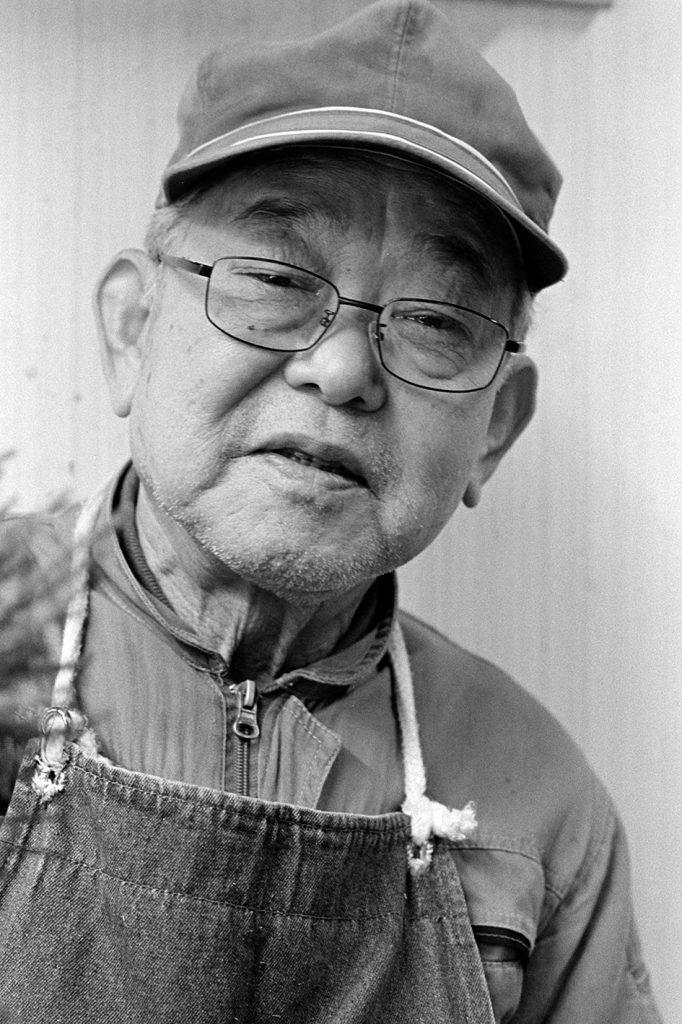
In Chizu, a small town in the mountains about 40 km from Tottori City, I met Yamamoto-san, an older man who was handcrafting a sugidama. His workshop was in the front porch of his house, which opened directly onto the sidewalk via a sliding wooden door with several windows. Using a base made of wire he was inserting the leaves from sugi trees (cedar) to fashion a round ball, trimming the outer ends to make a uniform surface. Sugidama are used in the manufacture of sake, or more correctly the marketing of sake. The sugidama will hang in front of the house of the sake brewer. Initially the ball is green but it gradually turns to brown as the cedar leaves dry out. When the sugidama has turned completely brown, customers know that the year’s vintage of sake is available for sale.
A true street portrait, both in the sense of the context and the technique. On the sidewalks of Hiroshima, occasionally I saw young women wearing a distinct style of kimono, with a high waistline tied with obi and long flowing sleaves. I struck up a conversation with two such kimono-clad women, who explained that women working in certain shops in Hiroshima commonly wear such kimono. They both acceded to my request to take their photograph. This street portrait is a bit out of the ordinary in that the woman betrays a certain wariness in her face, which elevates the portrait out of the ordinary, in my opinion.
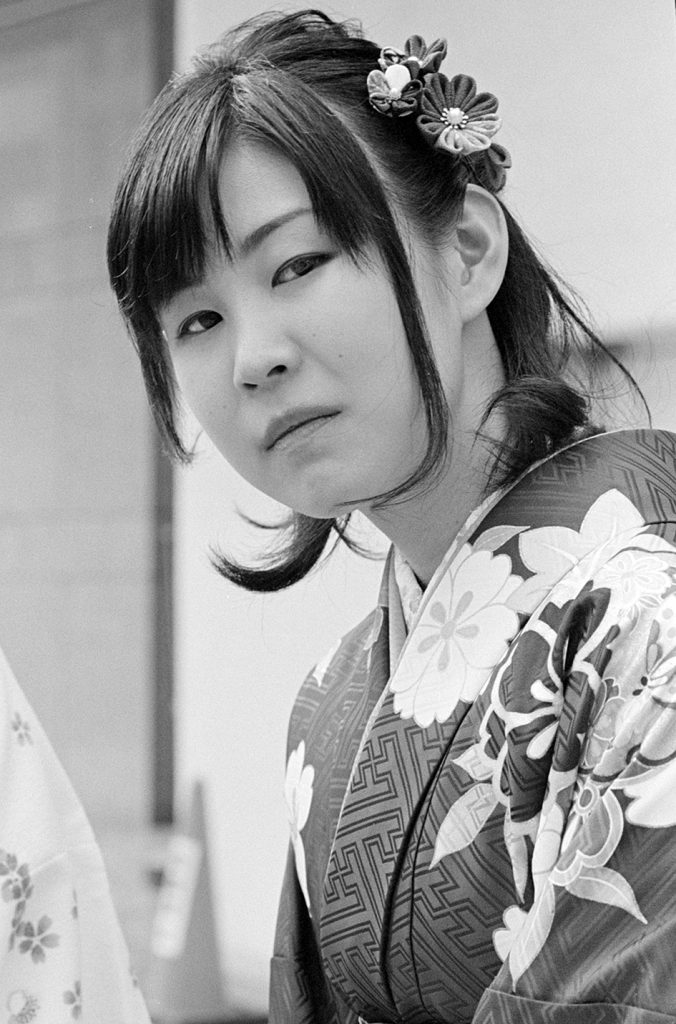
Quite an unconventional composition for a portrait, but in my point of view this is akin to a street portrait. Maybe I won’t describe the context, but only say that this woman was at work. This was a shot-from-the-hip photograph, so any shortcomings in the composition are inherent in the technique. The spontaneity of her body language more than makes up for any flaws in the image.
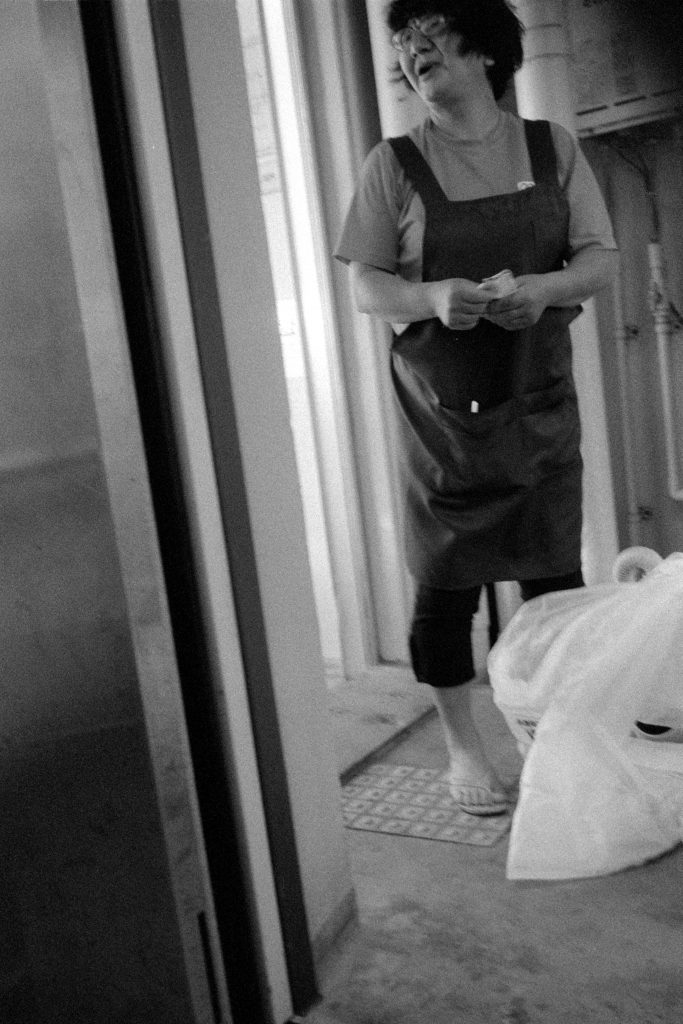
Train Travel
Let me now turn to views that are directly related to train travel rather than to street life. The view from the window of a moving train tends to focus on the scenery in the distance but when the train makes a station stop the focus shifts to activity on the platform. The station stops in Japan are brief but occasionally my camera finds a bit of drama on the platform.
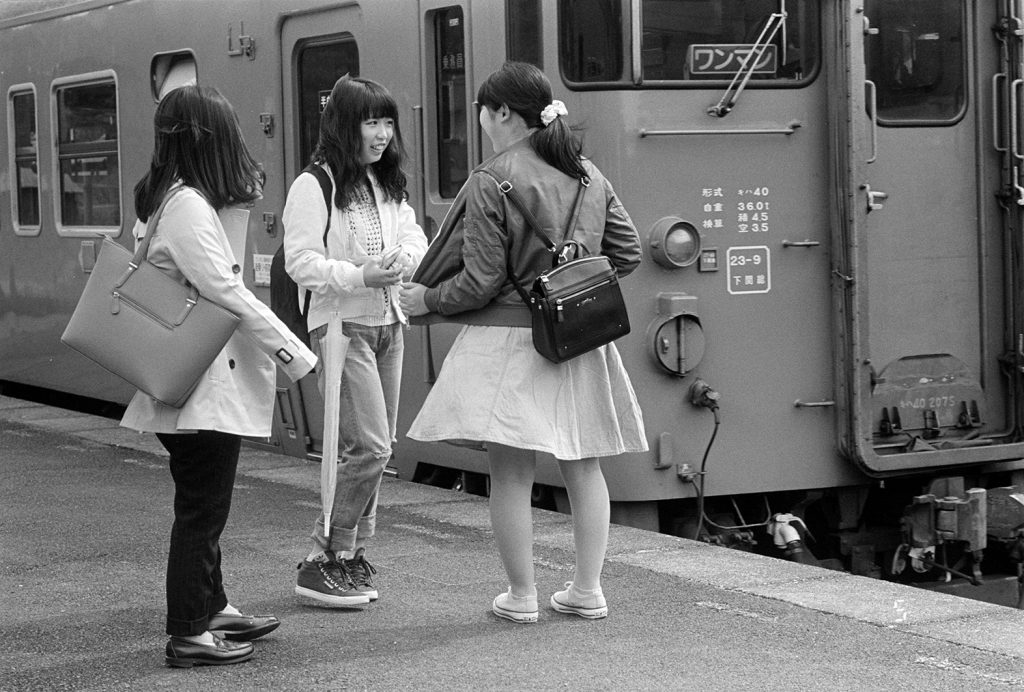
What they were actually doing is not the essence of this image, though. The image tells a story but one that can be different for each viewer. It invites your imagination to create your own story. Is this just three young women on a train platform? I think not. Shimane Prefecture

This may appear to be a scene from a TV drama or a soap opera. It is not. This is reality as seen from a train window. Shikoku Island
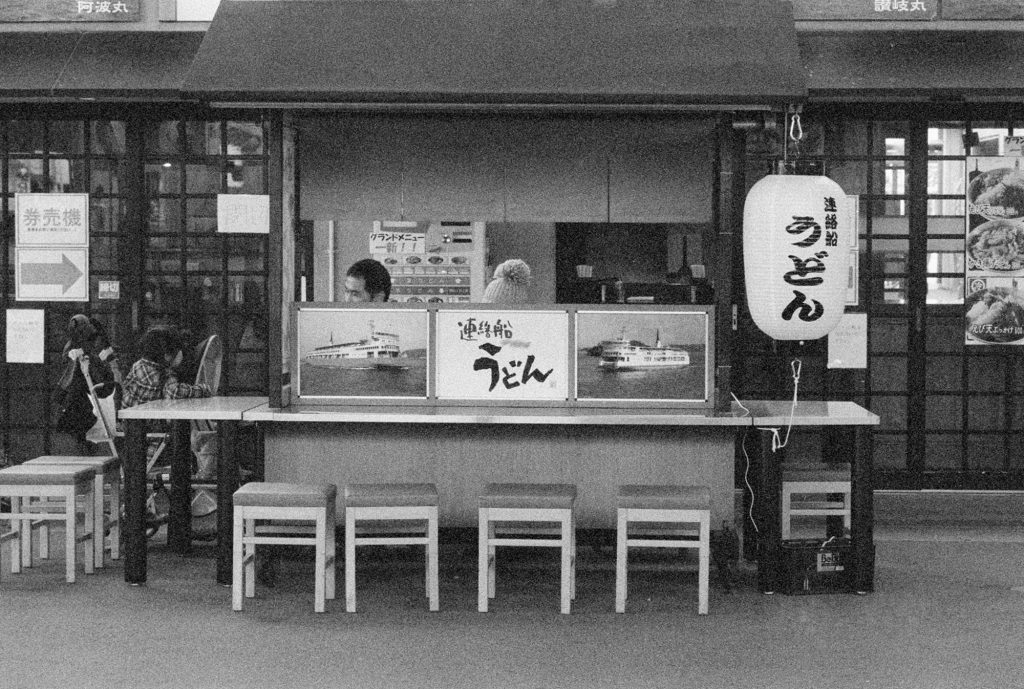
Train stations often present a chance to taste local cuisine. This shop offered sanuki udon, a specialty in Kagawa Prefecture on Shikoku Island. Udon, which basically is thick wheat-flour noodles in broth, might be considered Japanese soul food, hearty and satisfying.
Quite a distinctive atmosphere pervades this image of a lone woman walking along a train platform. She is too far away to reveal much detail but her determined stride and her body language propel the story. In this instance the woman was moving and the train was stationery, and a minute later she would be out of the frame. From my perspective as a photographer, this image asks, “What can I do while waiting at a station stop?” I can watch what is happening on the platform.
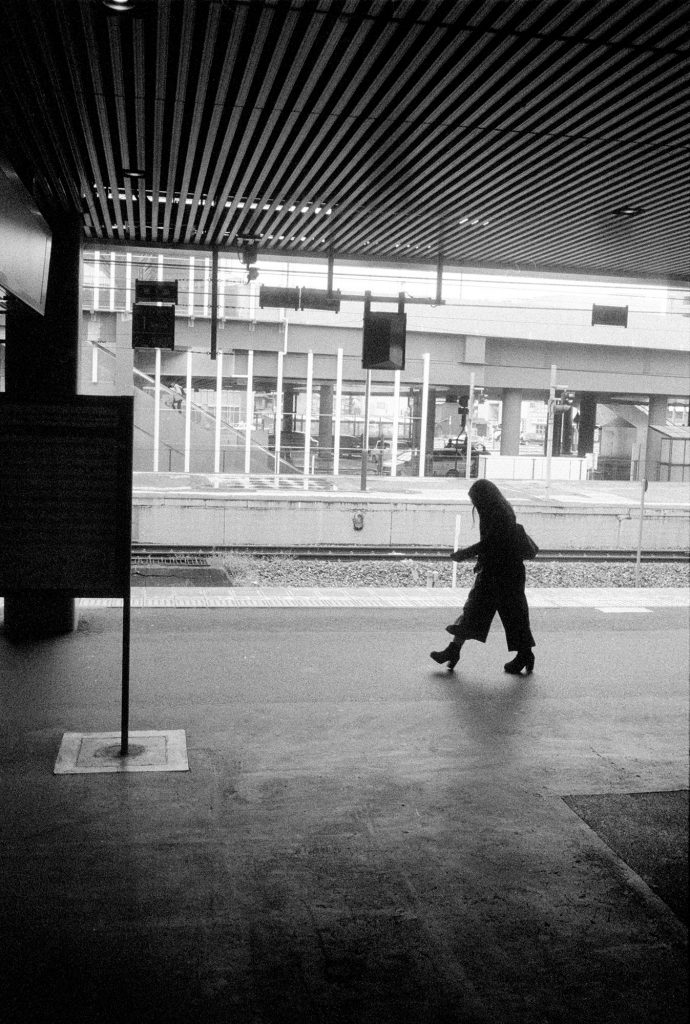
This was a quick-grab shot but the complex composition still manages to focus attention on the woman. A lone figure on the platform is unusual. Her motion animates the image. The photograph has a painterly feel and approaches an abstract style. It holds a wide range of tones and textures but they help to focus attention on the silhouette of the woman, rather than detracting from her. Overall, the mood of this image is poignant.
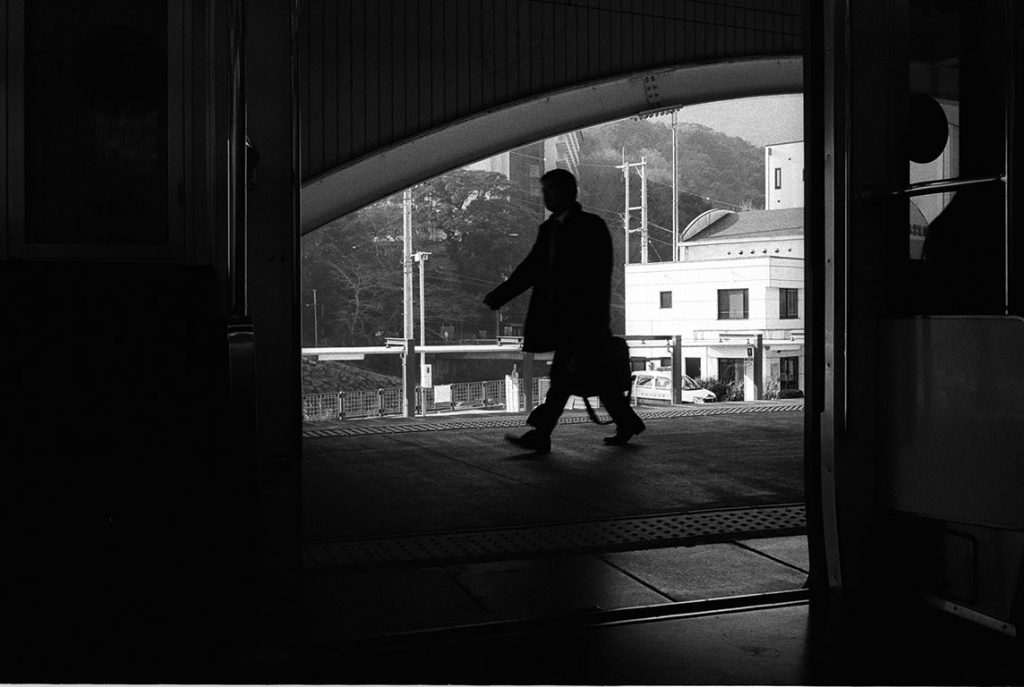
Black and white seem to be reversed in this scene. The interior of the train car seems to be dark and the figure on the platform appears only in silhouette. A critic might say this results from a failure of auto-exposure but I prefer to think of it as a lucky accident.
Reacting to the strong backlighting, my camera was able to focus on the action in the scene, the salaryman striding purposefully along the platform. The unknown elements here are the location (a resort town in Hakone) and the time (Saturday morning). A salaryman wearing a suit and carrying a briefcase would seem out of place here, but this adds a hint of mystery to the image. Nothing would seem to be what it actually was.
My narrative has strayed quite far from the more standard street photography (if such a genre actually exists) so now it is time to get the narrative back on track. Most of my street photography outside Tokyo comes from the early years after I moved to Japan in 2003 and the theme was nightlife in the cities. This series of images reflects another dilemma I faced during my travels: the question, “When is street photography not street photography?”
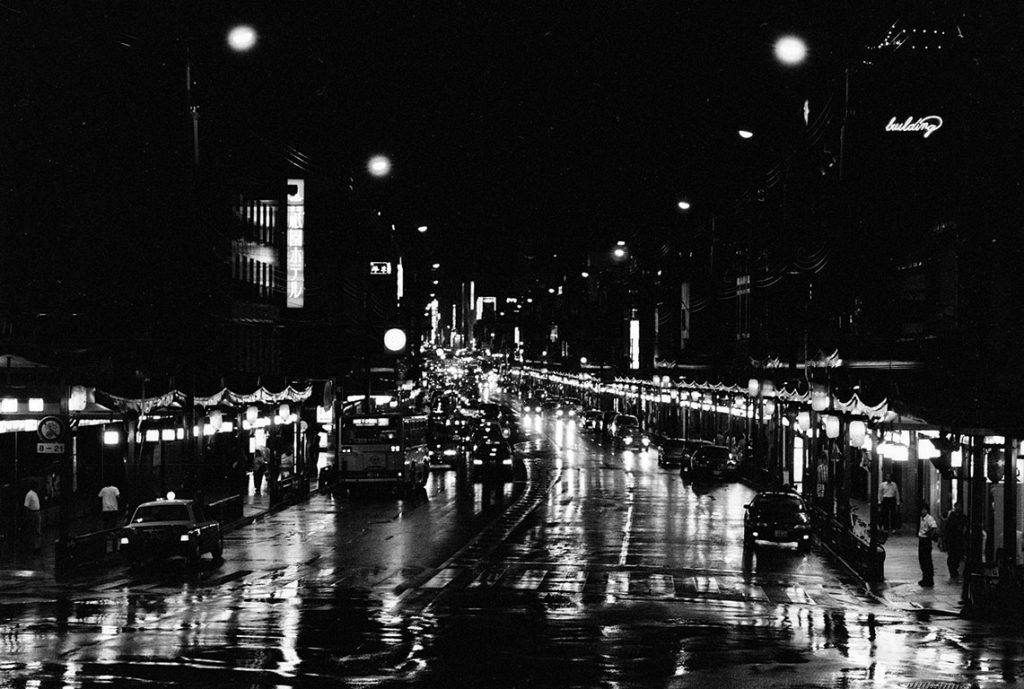

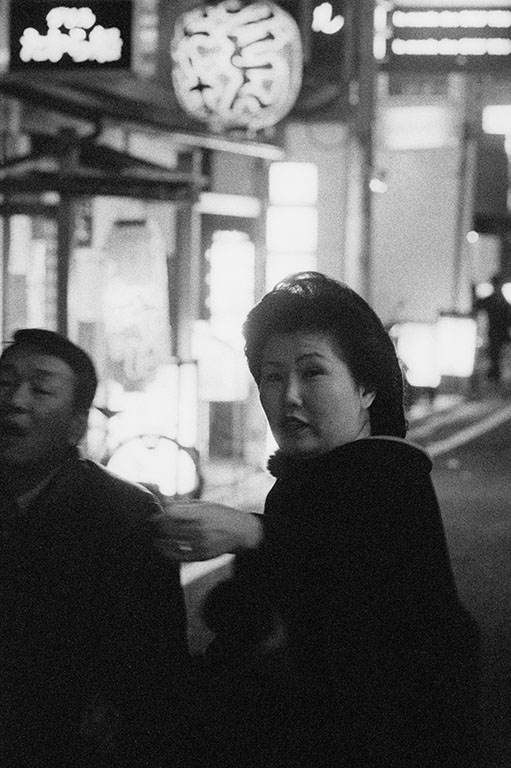
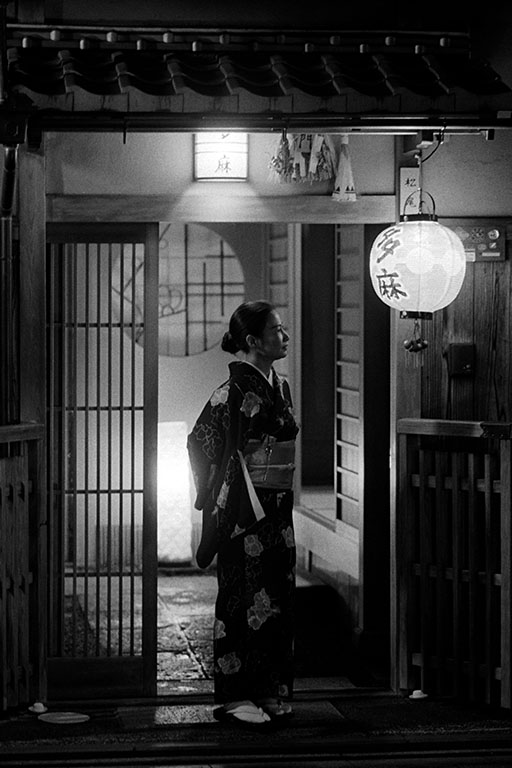
In retrospect, then, I see that my definition of “street photography” has evolved, has become “not street photography”. I found my own voice. Needless to say I continued with my “not street photography” as I traveled around Japan.
Nightlife without Street Life
Were I to describe the mood in a small town in the remote areas of Japan in a single word it would be “quiet” or maybe “vacant.” The street lights are on but no one is there. Coming from Tokyo, I found this disquieting. As a photographer, it was a challenge – how to capture an absence?
Street life, at least as I know it, seemed almost nonexistent in small towns and even in smaller cities in the more remote provinces. The absence of street life frustrated me for a while but then it became an element of my street photography. For, you see, my camera lead me to continue exploring this different venue. Thus, my street photography in the 47-prefectures series is inherently different from my work on the city streets.
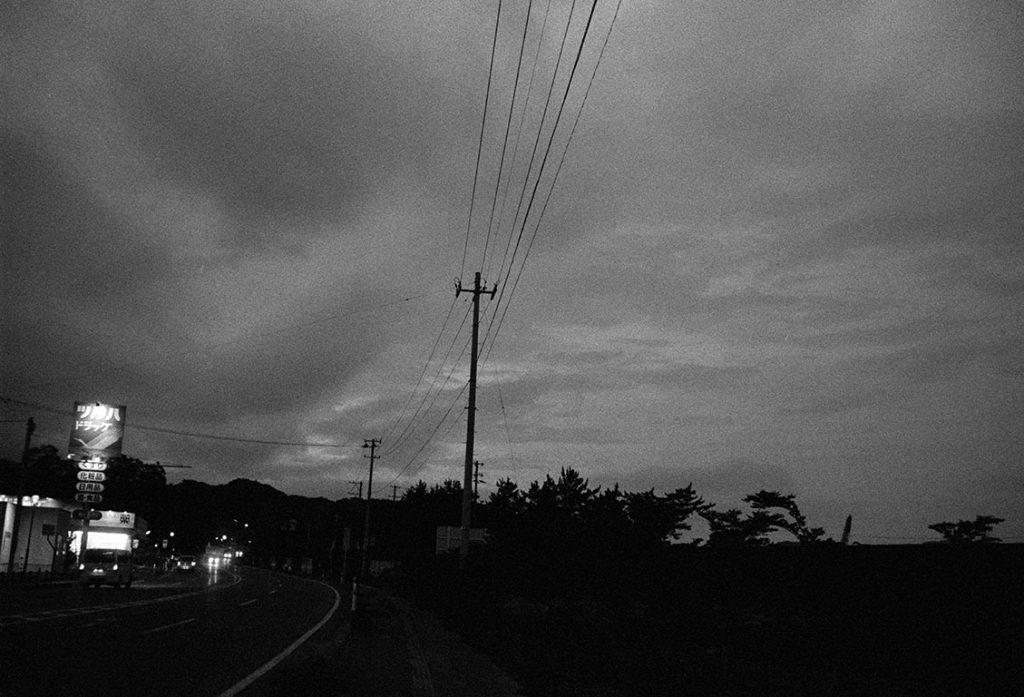
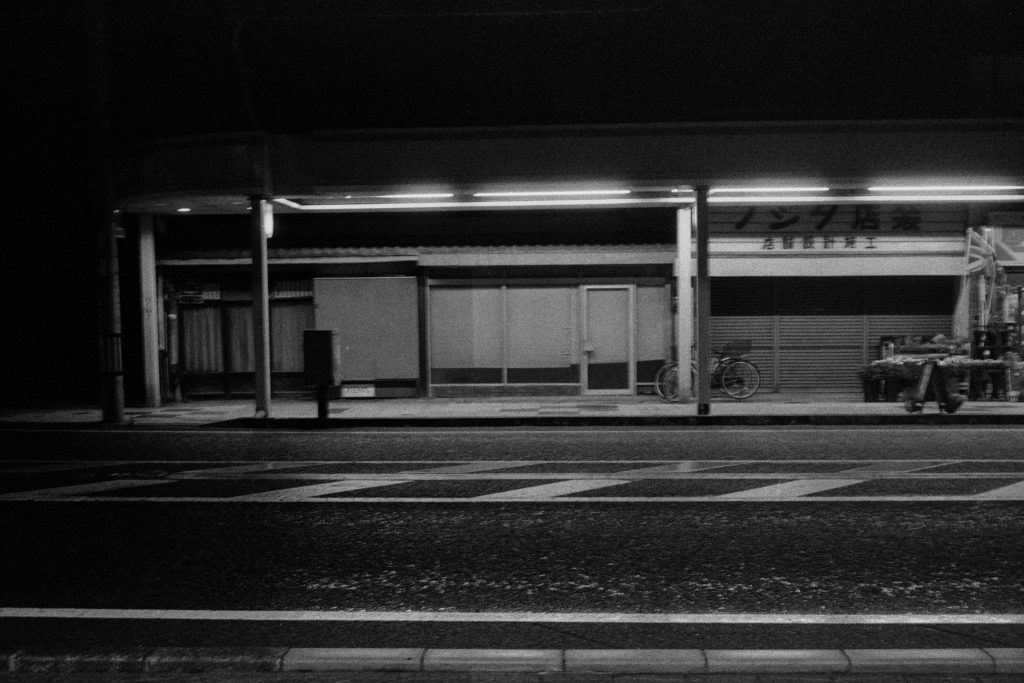
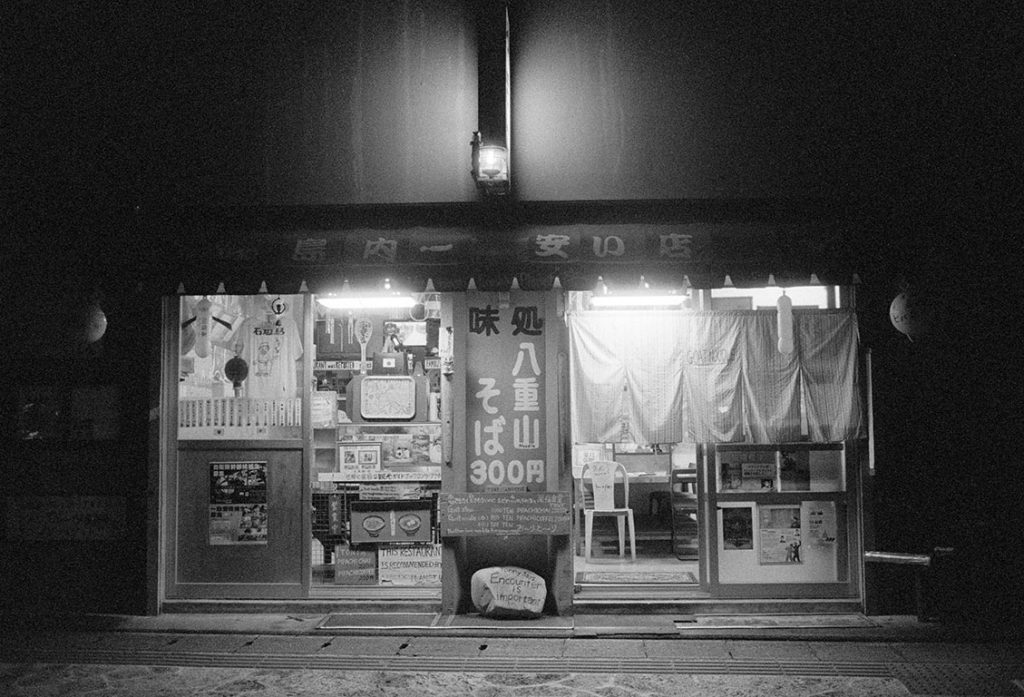
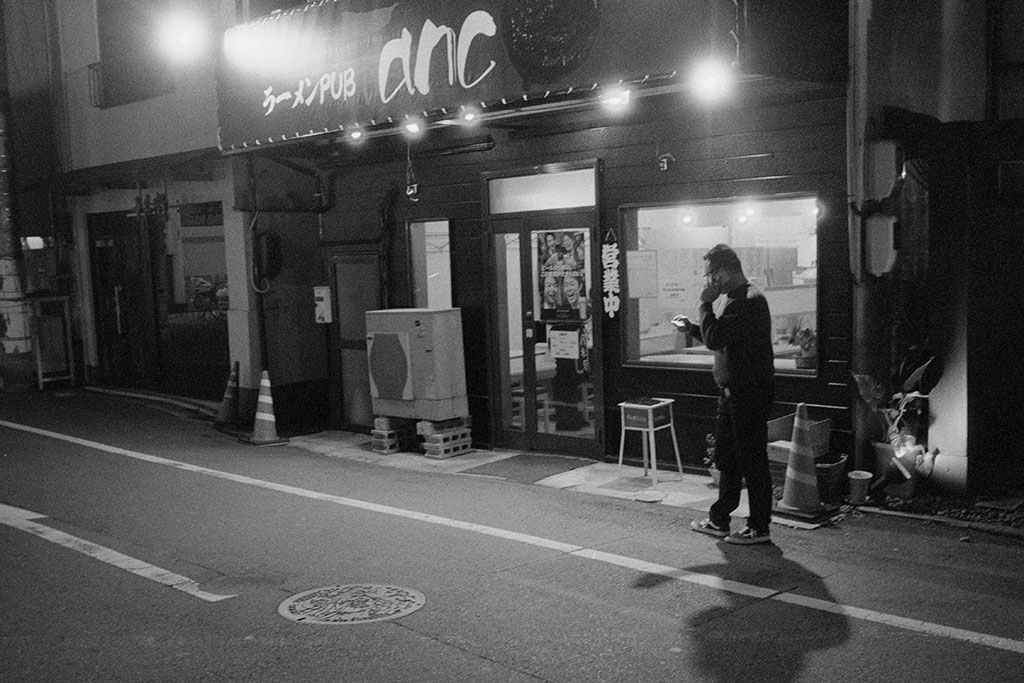

Segue. Let me end this episode with two photographs that may seem to deviate from my usual style. During the 47-Prefectures project, many times I found myself in environments that seemed alien to me – far removed from my usual life in Tokyo. This is not surprising, of course. The challenge for me was to yield to the spirit of the place. Let go of any preconceived ideas. As such, my style of photography exceeded its usual boundaries.
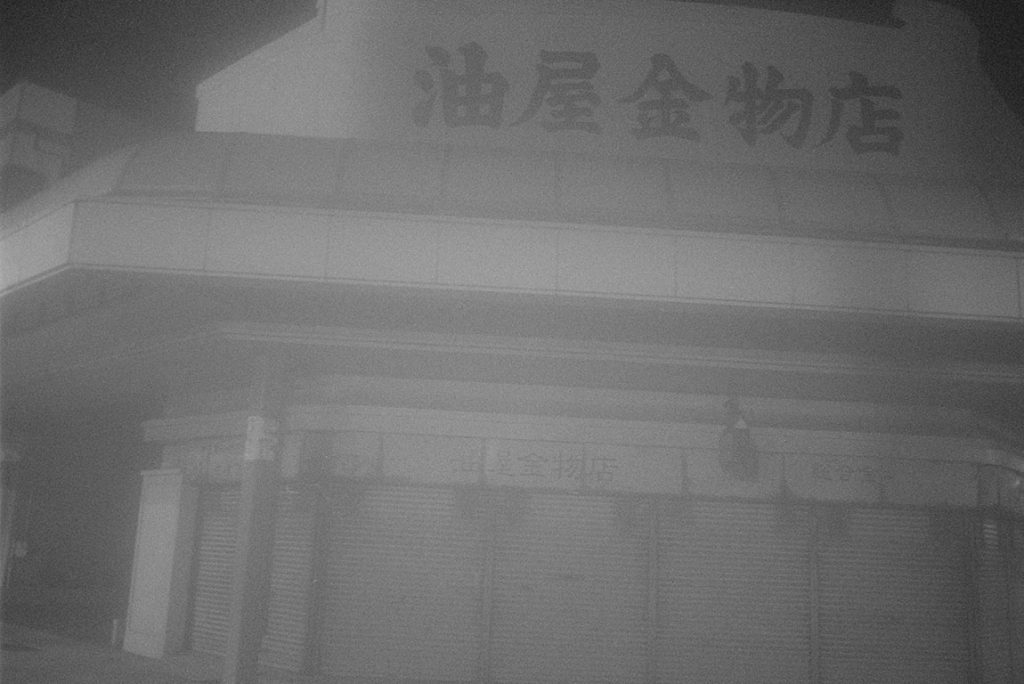
Who says that street photography must feature people? I can create my own definition, in this case “not street photography.” The sidewalks of Choshi, a small town on the Pacific coast of Chiba, were mostly vacant in the evening, and few cars were on the streets. A fog created an eerie, other-worldly, yet somehow romantic mood.
This image actually could fit into another genre of photography. I like to think of it as an abstract image. It exists outside of time and place. It expresses only itself. A viewer could easily get lost in such images. This is very satisfying for me as a photographer. I did not consciously plan this effect, it just happened. This style crept up on me at other places in my journey through the prefectures. Maybe they hold a subconscious message?
As a bit of trivia, Choshi is known for the manufacture of high quality soy sauce. The building in this image houses one of the soy sauce companies.
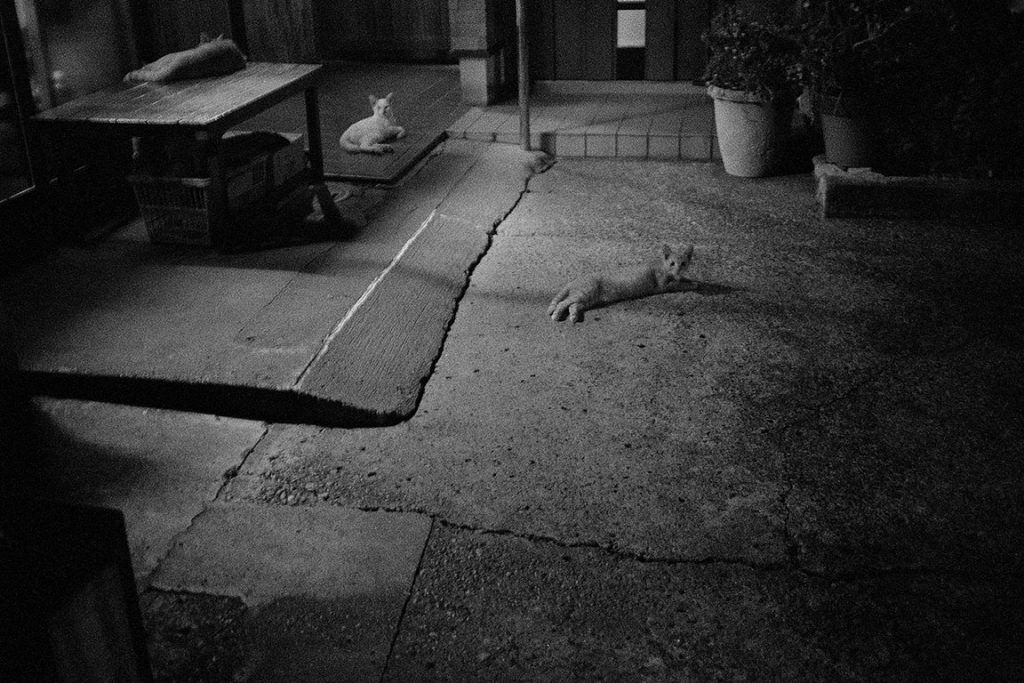
These cats were lounging in front of a house on one of the main streets in Katsuura, a resort town in Chiba Prefecture. In a way they symbolize that the streets at night were quiet and safe. The cats peered at me languorously as if to say, “Oh, well…” Initially, I walked passed this house and the scene with the cats registered dimly on my retina. A few steps later my little voice told me to stop and go back. Cats are far down on my list of favorite subjects but sometimes the heart overrides the brain.
This is the first of five episodes of The Monochrome Chronicles reporting on my 47-Prefectures project. The theme is street life in the prefectures, captured largely with the techniques of street photography but with two detours from the tradition of that genre.
In this episode of the Monochrome Chronicles, I’ve introduced what may well be a novel genre, which I call “not street photography.” Echoing a sentiment I’ve described occasionally in the Chronicles, this series of not-street-photography arose more from serendipity than from prospective planning. Another way of looking at it would be making lemonade when life gives you lemons.
My motivation, or maybe my compulsion, to photograph life on the street at night continued unabated even though the streets in these small towns seemed to be almost devoid of life. Let me qualify that statement and say, “…almost devoid of life as I have experienced it at night in large cities.” Surely, life would continue in the small towns after the sun goes down. Life simply continued behind closed doors.
Maybe a brief story will illustrate what I’m trying to say. Late one evening in the small town of Miyako in Iwate-prefecture, I set out to find an izakaya and eat dinner. This was maybe 8:00-9:00 PM and to my chagrin the streets were vacant and all the izakaya seemed to be closed. Finally I saw an izakaya which, though its outdoor lights had been turned off, the door was open and the interior lights were still on. Only two people, the izakaya owner and one customer were inside. From my travel log: “There a lively 77-yr old man, the only other customer, struck up a conversation. He spoke so animatedly but unfortunately I could understand little. Sometimes the izakaya mama-san could explain to me. I wanted so much to photograph him but he declined my request. His stories and his hands were so expressive. I believe he described his encounter with a yakuza in Ikebukuro some 20 years ago. He even acted out the facial expression, the voice, the gestures and the stance of that guy. The arm stretched out with waving hand to say, ‘Come here, you!’ Too bad that I couldn’t follow the outcome of their encounter. My new friend didn’t use the term ‘yakuza’ but only the gesture to show a knife scar across the cheek. That I could understand.”
I guess maybe my description of “nightlife without street life” is off the mark to some extent. Nonetheless, the photographs in this episode of the Chronicles portray my impressions as an outsider visiting these small towns.
In the next episode, I will expand further on nightlife in the 47 prefectures – specifically, my search for izakaya.
